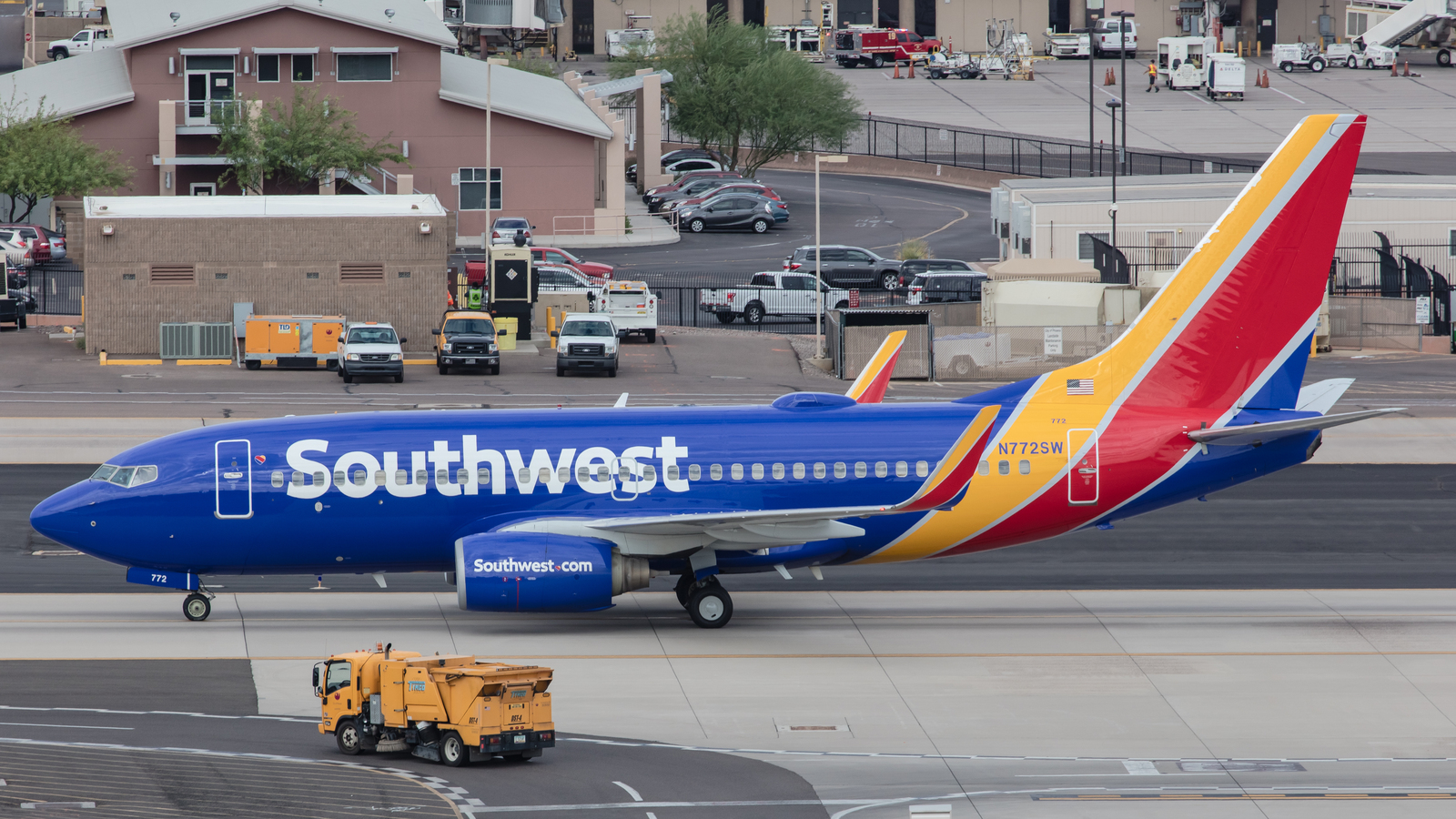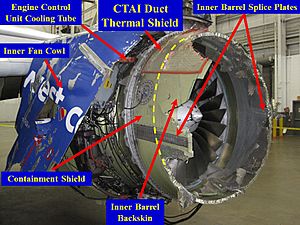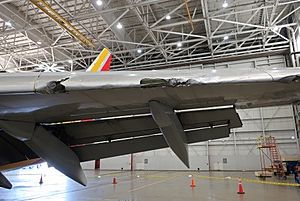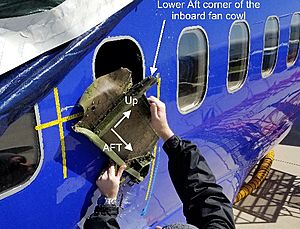Southwest Airlines Flight 1380 facts for kids

N772SW, the aircraft involved in the accident photographed in 2016
|
|
| Accident summary | |
|---|---|
| Date | April 17, 2018 |
| Summary | Engine failure leading to rapid depressurization |
| Place | Over Pennsylvania, United States |
| Passengers | 144 |
| Crew | 5 |
| Injuries (non-fatal) | 8 |
| Fatalities | 1 |
| Survivors | 148 |
| Aircraft type | Boeing 737-7H4 |
| Airline/user | Southwest Airlines |
| Registration | N772SW |
| Flew from | LaGuardia Airport, New York City, New York, United States |
| Flying to | Dallas Love Field, Dallas, Texas, United States |
Southwest Airlines Flight 1380 was a flight from New York to Dallas on April 17, 2018. The plane, a Boeing 737-7H4, had a serious problem with its left engine. A part of the engine broke off and hit the plane's body, causing a window to break. This led to a sudden loss of air pressure inside the cabin, which is called explosive depressurization.
The flight crew quickly made an emergency landing at Philadelphia International Airport. Sadly, one passenger was partly pulled out of the broken window and later died. Eight other passengers had minor injuries. The plane itself was badly damaged.
This accident was very similar to another one that happened 20 months earlier. In that event, Southwest Airlines Flight 3472 had the same type of plane and engine. After that first accident, the engine maker, CFM, asked airlines to check certain engine parts. Southwest Airlines had not checked the engine on Flight 1380 because it didn't fit the exact rules for the check.
This was the first time a passenger died in a U.S. airline accident since 2009. It was also the first time a passenger died in an accident involving Southwest Airlines.
Contents
About the Flight
Flight 1380 was a regular flight from New York LaGuardia Airport to Dallas Love Field. The plane, named N772SW, was a Boeing 737-7H4. It had been flying for Southwest Airlines since 2000. It used CFM56-7B engines.
The pilot in charge, called the captain, was Tammie Jo Shults, 56. She used to be a fighter pilot for the United States Navy. The co-pilot, called the first officer, was Darren Lee Ellisor, 44. He had been a pilot in the United States Air Force. Captain Shults had flown over 11,000 hours, mostly on the Boeing 737. First Officer Ellisor had flown over 9,500 hours, also mostly on the Boeing 737. There were five crew members and 144 passengers on board.
How the Investigation Unfolded
After the accident, the National Transportation Safety Board (NTSB) started an investigation. They worked with other groups like the Federal Aviation Administration (FAA), Boeing, and Southwest Airlines. Because the engine was made by a US-French company (CFM), French investigators also helped.
Investigators used radar information to find where parts of the plane's engine had fallen. They found pieces of the engine cover, called the nacelle, near Bernville, Pennsylvania. This was about 60 miles (97 km) northwest of Philadelphia.
Engine Checks and Safety Rules
Soon after the accident, the engine maker CFM told airlines to check certain engine parts. The FAA then made this a rule, called an emergency airworthiness directive (EAD). This rule said that fan blades on CFM56-7B engines with many flight hours needed to be checked using special ultrasonic inspections. If any cracks were found, the blade had to be removed.
Southwest Airlines decided to go even further. They announced they would check all CFM engines in their entire fleet of Boeing 737s, even if they didn't meet the exact requirements of the new rule.
The damaged plane was later flown to a repair facility in Everett, Washington. The FAA also issued another rule that required even more engine inspections, including for engines with fewer flight hours. This new rule also required regular checks.
In June 2018, the plane was moved to a storage facility in Victorville, California. It has not flown since the accident.
What Investigators Found
The NTSB shared some early findings:
- Most of the engine's front cover was missing.
- The fan case, which holds the fan blades, had a hole where a blade had hit it.
- One of the engine's fan blades, number 13, had broken off at its base.
- Investigators found that the broken fan blade showed signs of metal fatigue. This means the metal had become weak over time from repeated stress, like bending or twisting. The crack started very small and grew larger.
- The engine's fan blades had been used for more than 32,000 flights. They had been checked and oiled regularly.
- The plane's left wing, left side of the body, and left tail also had a lot of damage from the engine parts. A large mark near window 14 matched a piece of the engine cover that was found.
Final Report and Safety Advice
The NTSB held meetings to discuss their findings. In November 2019, they released their final report. They said the main reason for the accident was a crack in fan blade number 13. This crack caused the blade to break off and hit the engine's fan case. This impact then caused parts of the engine cover to break off and hit the plane's body near a window, leading to the window breaking, the cabin losing air pressure, and the passenger's death.
The NTSB suggested that the FAA should make Boeing find out which parts of the engine fan case could cause damage to the engine cover. They also recommended that Boeing should redesign the engine cover so it stays together even if a fan blade breaks off.
After the Accident
Many people praised the pilots for safely landing the plane. The U.S. Secretary of Transportation, Elaine Chao, thanked the crew and passengers for their help. A member of Congress also honored Captain Shults.
On May 1, 2018, U.S. President Donald Trump welcomed the crew and some passengers to the White House. He thanked them for their bravery.
Southwest Airlines gave each passenger $5,000 and a $1,000 travel voucher. After the accident, Southwest Airlines saw fewer people booking flights, which affected their income. One passenger filed a lawsuit against Southwest Airlines, saying she suffered from post-traumatic stress disorder. This lawsuit was later settled.
Captain Shults wrote a book about the incident called Nerves of Steel.
The plane, N772SW, was flown to Boeing for repairs. It was then moved to storage in Victorville, California, and has not flown a regular flight since. Its Southwest Airlines name has been removed, but it still has the airline's basic paint design.
Images for kids
See also
 In Spanish: Vuelo 1380 de Southwest Airlines para niños
In Spanish: Vuelo 1380 de Southwest Airlines para niños









